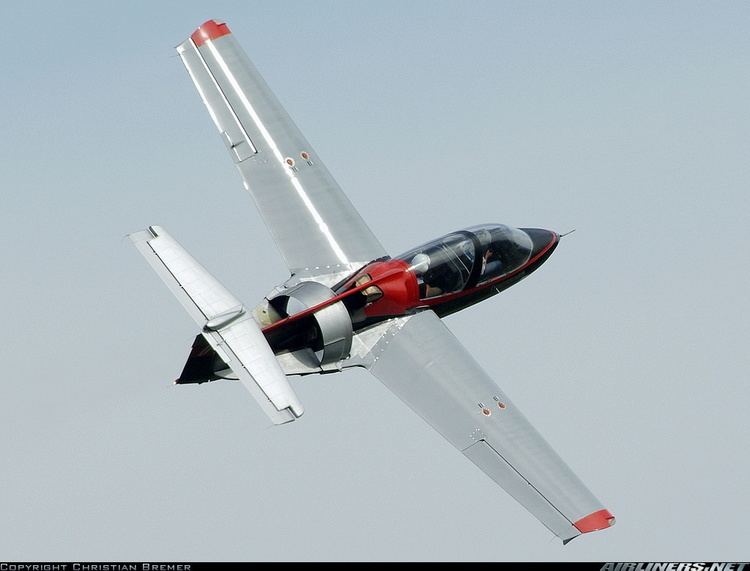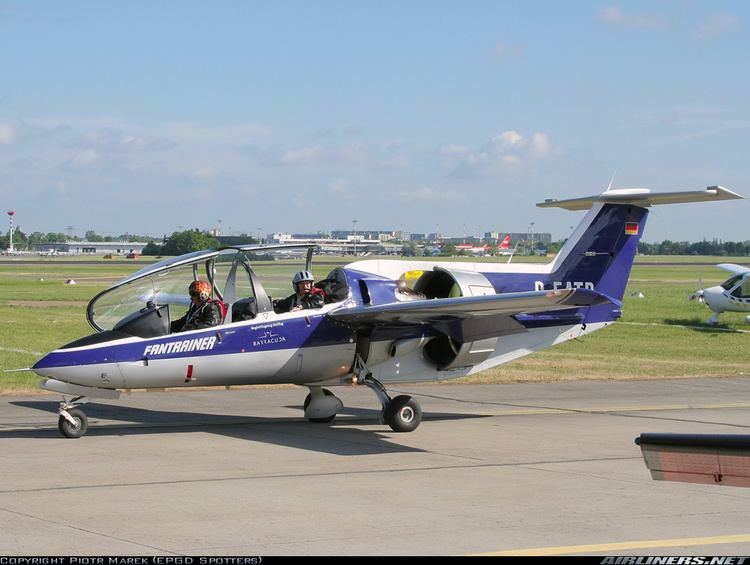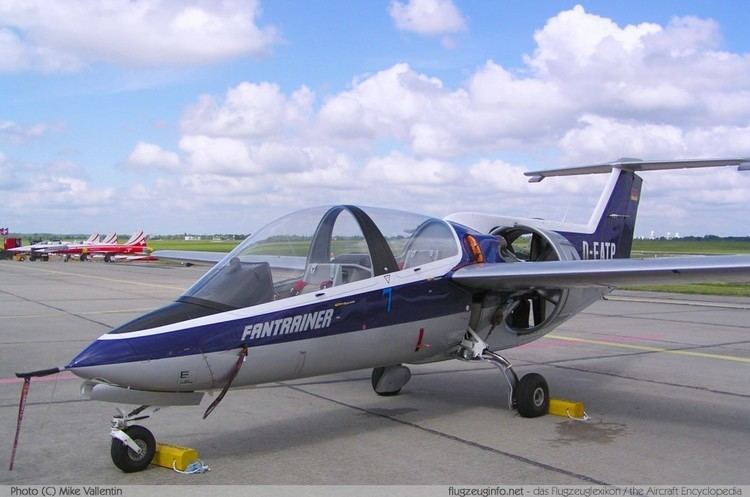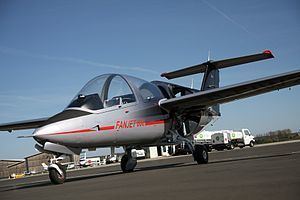Top speed 417 km/h Length 9.2 m First flight May 31, 1978 | Wingspan 9.74 m Introduced 1982 | |
 | ||
Rfb fantrainer
The RFB Fantrainer (or Fan Trainer) is a two-seat flight training aircraft which uses a mid mounted ducted fan propulsion system. It was developed by Rhein-Flugzeugbau GmbH (RFB) in Germany in the late 1970s and used by the German and Thai air forces. It won a competition in Germany beating the Pilatus PC-7 and Beechcraft Mentor as the best solution to the Luftwaffe's Basic Trainer Requirement. However, no orders were forthcoming as Germany had committed to buying US Fighters (F4 Phantom and F-104 Starfighter) which included a deal for pilot training in the USA. Lufthansa was also interested in the aircraft due to its jet-like handling. Users confirm it is very fuel-efficient and provided a true "jet feel" for a reasonable price. The Royal Thai Air Force used the FT400 and FT600 versions to train ab initio pilots who then went on to fly the Northrop F-5E fighter aircraft. In conjunction with the intended new production of the Fantrainer, initiated by the Fanjet Aviation GmbH in Germany, the Fantrainer 600 was renamed as "Fanjet 600".
Contents
- Rfb fantrainer
- Edf rfb fantrainer 2
- Design and development
- Variants
- Ranger 2000
- Operators
- Specifications Fantrainer 600
- References

Edf rfb fantrainer 2
Design and development

The German company Rhein Flugzeugbau developed an interest in aircraft powered by ducted fans integrated into the fuselage in the 1960s, flying two modified gliders as testbeds in 1969 and 1971. In 1970 it announced a new project for a two-seat ducted-fan military trainer, intended to offer jet-like handling at low cost. In March 1975, RFB received a contract from the German Defence Ministry for two prototype Fantrainers for evaluation as replacements for Piaggio P.149s used as initial trainers by the Luftwaffe.

The first prototype (registration D-EATJ), powered by two EA871 110 kW (150 hp) NSU Wankel engines, made its maiden flight on October 27, 1977. This engine installation proved troublesome, and the second prototype (D-EATI), fitted with a single 310 kW (420 shp) Allison 250-C20B turboshaft engine, flew on May 31, 1978. The second prototype crashed on September 7, 1978, which resulted in the first prototype being modified to Fantrainer 400 standard, with an Allison engine and revised air intakes. The Fantrainer was evaluated by the Luftwaffe against the Beechcraft T-34C and Pilatus PC-7 turboprop powered trainers, but although it was considered to be the most suitable of the three aircraft, being cheaper both to purchase (at DM 1 million per aircraft) and to operate, no orders resulted as it was decided that the Piaggio P.149 was still adequate for the Luftwaffe's needs.

The aircraft was finally produced in two models, the Fantrainer 400, powered by a 545 shp (406 kW) Allison 250-C20B, and the Fantrainer 600, which was powered by a 650 shp (480 kW) Allison 250-C30. In both, the turboprop engine drives a pusher fan. The wings are swept 6° forward to keep the center of gravity balanced and the four 96-litre capacity fuel cells are integral with the wing structure.

In August 1982, the Royal Thai Air Force signed a contract with RFB to buy 47 aircraft, 31 of the model 400 and 16 of the 600. They were assigned to the 402 Squadron and used as a step-up trainer for their future F-5 Freedom Fighter pilots. The step-up characteristic of the Fantrainer generally covers one of its main advantages. The training ability for pilots through a Fantrainer is almost fully covered and only supplemented by an Advanced Trainer for the purpose of getting a high performance jet training and experience. The first two aircraft were built in Germany, and the remaining aircraft were assembled in Thailand from kits shipped from RFB. After an initial period of operation, the RTAF elected to replace the aircraft's glass fiber wings with locally produced aluminium wings, even when the original fiber glass wings proved to endure well in the hot and humid Thailand weather, which was a main concern of the manufacturer.
In 1986 the Fantrainer was again evaluated by the Luftwaffe in an armed configuration and as a jet trainer but no orders were placed. The end of the cold war simultaneously displayed the termination of the alpha jet program. The alpha jet used to be a light attack aircraft as well as an advanced jet trainer to that time, used by pilots in their succeeding training phase after their initial training by the Fantrainer.
The Fanjet Aviation GmbH bought the documentation for the design, test- and certification of the Fantrainer 600, which it has renamed the Fanjet 600. Furthermore, the company acquired the trademarks of “RFB, Rhein- Flugzeugbau" and “VFW, Vereinigte Flugtechnische Werke".
Variants
Ranger 2000
In the early 1990s RFB and Rockwell International developed in a joint venture a jet-powered variation of the Fantrainer under the denomination Ranger 2000, which was evaluated as a trainer aircraft in the JPATS contest by the USAF and the U.S. Navy, but no orders were placed as the aircraft lost to the T-6 Texan II. One of the two prototypes crashed during evaluation. The Ranger 2000's turbofan engine was a Pratt & Whitney Canada JT15D.
Operators
Specifications (Fantrainer 600)
Data from Jane's All The World's Aircraft 1988–89
General characteristics
Performance
